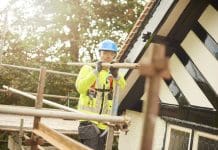Peter Ward, Partner at Heritage Consulting Ltd examines how traditional buildings can still meet warranty conditions after renovations have taken place, along with the different skill sets and knowledge required to undertake the work properly…
As ‘Historic Building Surveyors’ our practise constantly deals with the clash between building regulations requirements, and the needs of historic buildings to breathe. Building Control Officers (BCO’s) can only work with the scope and content of the regulations they are given.
When I first started working with old buildings, I was ridiculed for my use of the word ‘breathability’. Now, breathability is recognised in Part L1B and L2B – but sadly still only quoting ‘special considerations may apply’ (Para 3.8c).
We have come a long way from universal application of damp proofing, tanking, and cement rendering of our old buildings, to an acceptance of the fact we have been doing things very wrongly. This has been focussed with the release of British Standard BS7913: 2013 – Guide to the Conservation of Historic Buildings – a mammoth effort by IHBC, and main author, John Edwards. My only regret is the title – ‘Conservation’ as it conjures up thoughts of specialists, difficult work and strange ‘expensive traditional materials’. ‘Historic’ makes us think of National Trust, Listed Buildings and Historic England. The Standard could be more aptly be described as ‘Surveying and looking after Old buildings’.
For traditional buildings to have a chance of meeting warranty conditions after restoration, BCO’s need clear guidance that allows them to differentiate between an ‘old – traditional, or breathable’ building, and modern construction. They are not specialists in old buildings, nor have they trained to be – until recently there has been no requirement to pay anything but lip service to a few paragraphs (3.6 to 3.13 of L1B), often only when requested by a Conservation Officer in relation to a Listed Building.
We need to make a fundamental leap of faith, recognising that ALL old buildings, be they Listed or not, need the same treatment. There needs to be a clear definition of an ‘Old Building’ – one built using breathable materials, whether brick, stone, or timber, using lime mortars and plasters, mud or clay lump. The fact is that nearly 25% of our building stock is constructed this way.
Because of the lack of understanding of breathability, both by RICS surveyors, BCO’s, and many architects, the damp industry has thrived in this country since the early 1960’s. It is based on the inadmissible use of ‘damp meters’ which don’t even measure damp. This industry has instilled a culture of ‘damp and timber’ treatments within the survey, real estate, and building control industry. We are brainwashed into accepting and using the terms ‘Injection Damp Proof course’, ‘Rising Damp’, ‘Tanking’, ‘Remedial Damp Proofing’ – and associated ‘guarantees’ which are such a big part of most old house sales. We have never seen a single ‘guarantee’ honoured. We have never seen the mythical ‘rising damp’. It is ominous that a google search of ‘rising damp’ is confined to England – the United States is strangely free of the ‘rising damp’ which apparently blights our old houses. This industry is single-handedly responsible for most problems of retained moisture within the fabric of old buildings today. It is rare to survey a house that has inherently dry walls, and original breathable lime plaster, external walls free of cement strap pointing, and some form of damp proofing.
For work on an old building to allow it a chance of survival for another 100 years, those involved need to learn and understand the basis of breathability. They must understand the processes which take place within ‘traditional’ materials, and the reasons for failure – the return of dreaded ‘damp’ and associated decay processes. We need to boot ‘rising damp’ and the damp industry into the trash can, and introduce simple, structured training and advice for both the professionals, builders, craftsmen, and labourers involved.
There is a sea change taking place within the industry. Many more tradesmen are learning traditional skills – 5 years ago, finding a lime plasterer was akin to getting an audience with the Pope. Now, a google search reveals numerous entries, and Facebook, Twitter and LinkedIn are busy with recently completed projects by a growing army of traditional builders. Timber framing, lime plastering and stone masonry feature prominently in the courses run by the Heritage Craft Alliance, supported by the NHTG (National Heritage Training Group). The dark cloud on the horizon was a recent decision by CITB to cease funding the NHTG, seen by many as a refusal by government to support traditional skills training. BRE research by Colin King is showing that assumptions about heat loss in solid walls are incorrect. He recently told me “A DRY old house is a warm house”.
A recent example we have dealt with embodies many of the points made
We surveyed a recently completed development – a row of late 17th C Listed buildings, renovated and sold by a developer. Building Regulations complied with, and Conservation consulted extensively. Historic England asked whether ‘damp proofing’ recommended by the builder was suitable. Their advice was not to damp proof. Critically, NO specification was provided to the builder, either by the architect, Conservation, HE, or Building Control. The resulting development was sold, and within 12 months, many rooms in 3 houses were showing peeling plaster, damp, and mould. The builder had injection damp proofed, cement tanked every wall, and gypsum plastered. He had re-pointed in cement, and cement rendered the front elevation – in his words “To make sure it stayed dry”. These buildings are now being stripped and restored using traditional methods under our supervision – the builder is allowing independent craftsmen to undertake the works, funded by his liability insurance. Clearly, the builder was not at fault here – the project architect never understood the building fabric, Building Control approved standard conditions and clauses, and Conservation never specified ANY materials to be used. There was NO specification for traditional, breathable materials in any of the project documents.
The solution:
- Clear definition of the 2 types of building – breathable and modern;
- Acceptance by Building Control of the need for breathability in old buildings REGARDLESS of designation (as stated in BS7913);
- Accredited training for BCO’s, Architects, Builders, Surveyors;
- Greater resources for training of Heritage skills;
- Promotion of the work done by IHBC, STBA, BRE and others;
- An immediate stop to ‘damp proofing’ and ‘timber and damp’ surveys.
Guarantees can only become effective if the building fabric is properly assessed, and appropriate techniques and materials used. Those doing the work at all levels need appropriate accreditation.
None of the principles involved are hard to understand – but accepting them, and working with old buildings requires a quantum leap in attitude by ALL those concerned with the work. Owners are increasingly informing themselves via the internet – it is time for Architects, Surveyors, BCO’s and Builders to catch up! ■
. . . . . . . . . . . . . . . . . . . . . . . . . . . . . . . . . . . . . . . . . . . . . . .
Peter Ward
Partner
Heritage Consulting Ltd
Tel: 01746 862 640
midlands@heritage-consulting.org













